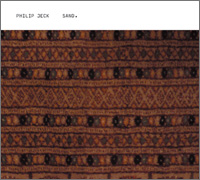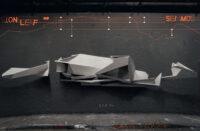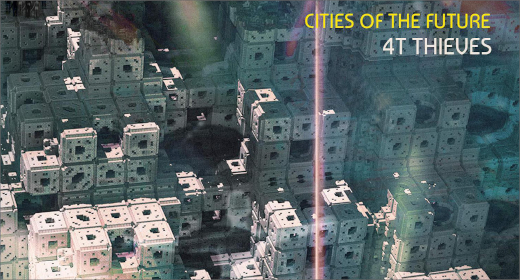 Turntablist Philip Jeck likes to boldly go beyond the vinyl frontier, though his music delights in the inbetween: in between sound art and music, aleatory and structured, pre-planned and indeterminate, abstraction and musicality, as well as between abrasive and non-pitch-specific tones and figures of melodic consonance. And interestingly, in terms of those generic epithets beloved of ambient reviewers, his pieces also malinger in between “dark” and “light,” being resolved towards neither (or perhaps both at once). And Sand‘s pieces are also suspended between aperture and enclosure, outfolding towards the stars, while scudding against the ceiling and below stairs.
Turntablist Philip Jeck likes to boldly go beyond the vinyl frontier, though his music delights in the inbetween: in between sound art and music, aleatory and structured, pre-planned and indeterminate, abstraction and musicality, as well as between abrasive and non-pitch-specific tones and figures of melodic consonance. And interestingly, in terms of those generic epithets beloved of ambient reviewers, his pieces also malinger in between “dark” and “light,” being resolved towards neither (or perhaps both at once). And Sand‘s pieces are also suspended between aperture and enclosure, outfolding towards the stars, while scudding against the ceiling and below stairs.
For those yet to check Jeck, he’s one of the few contemporary experimental sound artists directly descended from John Cage and Pierre Schaeffer, his turntablism steeped in a tradition with roots in early process-music experimentalism and musique concrète. This old sound-art collage kid turns base vinyl into something near to antique gold, sampling and looping needle-on-the-record surface noise, and itching his scratch perversion with two early ’60s record players with variable speeds, and nothing else but an old synth, a mixer and a guitar FX-pedal.
So, wrought almost entirely from scuffed and wrangled wax, the grain of Sand goes against you, but you find your ears going with it. The house that Jeck built is a haunted one of eerie remote presences, with sounds seeping up from a churning undertow of static and lo-fi drone before being effaced. The album starts out in the woozy click’n’pop soup of “Unveiled,” then moves on to “Chime Again,” which allows beautiful chiming timbres to stand proud of a base of plastic fantastic sampledelia. Three of the remaining tracks make diverse play with a fragment of Copeland’s “Fanfare For The Common Man.” The first, “Fanfare,” spools it out into wonky 70s TV intermission ambiance, allowing it to cling on to a grandiose faded beauty while buffeting it about. The second, “Fanfares Forward,” smears it into a grimy veil of mounting recursive progressions whose loopy gauze and queasy memory capture has something of the feel of another (albeit quite differently re-contextualizing) musico-culture vulture, Wolfgang Voigt. In the spaces in between, “Shining” and “Residue” lie low in repose, before finale “Fanfares Over” comes alive again to decompose Copeland and scatter his musical ashes over a slurry of loops run through what sounds like a massive antique flanger. The whole has a feel of the hit-and-miss about it, but what’s striking is how often and how powerfully it hits.
In closing, a reflection on the album’s title, which could secrete the germs of a meaning to the music’s methodical madness. Sand: perhaps an allusion to the particulate nature of its sound, but, equally, the properties of sand lead to associations with themes of time and/or impermanence, especially in combination with the discreet ellipses (…) appearing on the sleeve, and the accompanying fragment from Emily Dickinson’s The Chariot (better known to some as “Because I could not stop for Death…”) – a reflection on Time and Eternity. Like Bryars (The Sinking of the Titanic) or Basinski (The Disintegration Loops), Jeck understands the emotive heft of the sound of the decorous in decay. And though Sand doesn’t have a ready-made programme to patch itself into, it seems similarly disposed to explore the semiotics of damaged and/or aged sources, as it pushes ever further in its ethnography of evanescence into a multi-layered polytimbral in-between. One to Jeck.
Sand is available on Touch. [Purchase]


























